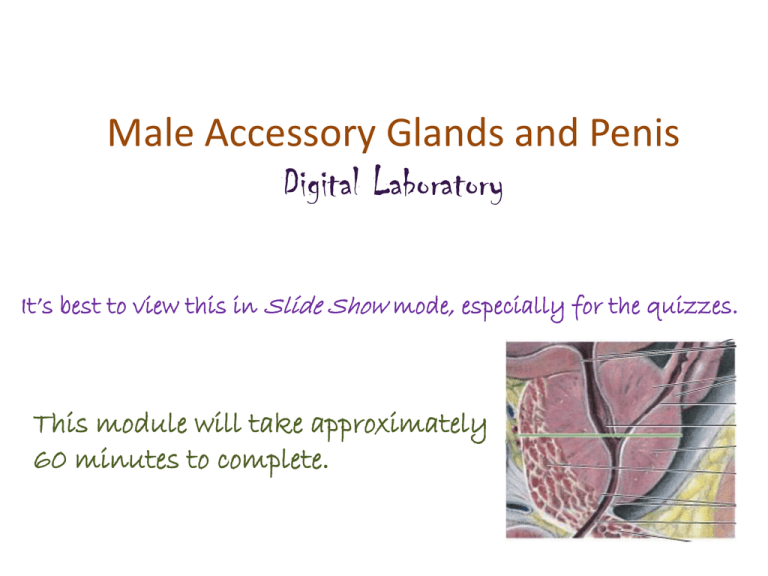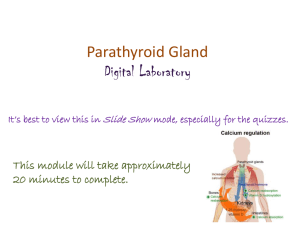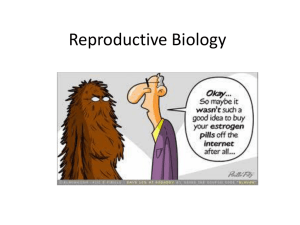
Male Accessory Glands and Penis
Digital Laboratory
It’s best to view this in Slide Show mode, especially for the quizzes.
This module will take approximately
60 minutes to complete.
After completing this exercise, you should be able to:
identify, at the light microscope level, each of the following:
Seminal vesicle
Mucosa
Muscularis
Adventitia
Prostate gland
Concretions
Urethral crest (colliculus seminalis)
Utricle
Ejaculatory ducts
Bulbourethral gland
skeletal muscle
mucous glands
Membranous urethra
Penis
Penile (spongy) urethra
Corpus spongiosum
Corpus cavernosum
This is a
reminder slide
from the digital
lab on testes
and ducts.
The urogenital
diaphragm (indicated by
the dotted green line) is
a thin sheet of mostly
skeletal muscle that
includes the external
urethral sphincter.
Membranous refers to
the part of the urethra
that passes through the
urogenital diaphragm.
The membranous
urethra is about 1cm in
length.
Major structures of the male reproductive system that allow for production and transmission of
sperm include:
Testis – produces spermatozoa
Epididymis – storage and final maturation of spermatozoa
Ductus (vas) deferens – transports spermatozoa to the prostatic urethra
Urethra – has three parts in the male, prostatic, membranous, and penile, named for the
structure that the urethra passes through
This is a
reminder slide
from the digital
lab on testes
and ducts.
These accessory glands
and the penis will be
covered in this module
Accessory glands that are adjacent to the main pathway secrete fluids:
Seminal vesicles – produce 65% of semen, its duct joins with the vas deference to become the
ejaculatory duct, which passes through the prostate to drain into the prostatic urethra
Prostate – produces 30% of semen, surrounds prostatic urethra
Bulbourethral (Cowper’s) gland – secretes mucus during arousal for lubrication of the urethra
Each seminal vesicle develops as an evagination from the vas deferens; each forming into a highly
folded tubular structure. Sectioning the seminal vesicle reveals several apparently distinct lumina;
however, note that these are all part of an interconnected lumen that becomes the duct of the seminal
vesicle.
The three regions of the wall of the seminal vesicle are (from inside to outside):
1. Mucosa - epithelium plus loose connective tissue
2. Muscularis – thick, fibrous smooth muscle layer that is very eosinophilic
3. Adventitia – outer connective tissue
Mucosa refers to an epithelium + underlying connective tissue that together form the inner lining of tubes that
are inside the body but are exposed to the outside world; e.g. the inner lining of the respiratory and digestive
tracts, and the urinary and reproductive structures all have a mucosa. Mucosa typically produces a secretion, so
the surface of the mucosa is moist. Many of these organs also have a muscularis and adventitia as well.
muscularis
These elaborate mucosal folds
create numerous “pockets” that
seem to be cut off from the main
lumen (e.g. black arrows, there
are many more in this image than
indicated). Each of these is
connected to the main lumen.
Closer examination reveals that each region of the seminal vesicle contains numerous folds of mucosa.
The folding of the mucosa in the seminal vesicles is often described as “lacey”.
Each region is surrounded by brightly eosinophilic bundles of a fibrous smooth muscle – the muscularis.
One of the borders between the muscularis and mucosa is indicated by the dotted line. Note that this is
not the location of the basement membrane – the basement membrane is between the epithelium and
connective tissue within the mucosa.
muscularis
Although the epithelium of the seminal vesicle is officially pseudostratified, the basal cells are less
numerous, making the epithelium appear simple columnar. There is some variation in cell height,
from cuboidal to columnar, but this is not as prominent as is the case for the efferent ductules.
The epithelium is supported by loose connective tissue (arrows), which forms the core of the folds,
and contains little, if any, smooth muscle. The muscularis that surrounds each region of the seminal
vesicle is indicated.
Video of seminal vesicle overview – SL56
Video of seminal vesicle – SL56
Video of seminal vesicle – SL161
Link to SL 056 and SL 161
Be able to identify:
•Seminal vesicle
•Mucosa
•Muscularis
•Adventitia
The prostate gland has the same general features as the seminal vesicle; mucosa with pseudostratified
epithelium, muscularis, adventitia. However, there are notable differences:
1. The lumen contains noticable concretions (black arrows).
2. The “lobules” of the prostate are much smaller, with noticeable smooth muscle interspersed
between them.
3. The folds of mucosa are much less elaborate.
4. The epithelium undulates; the taller regions appear to be stratified (outlined), even though the
epithelium, like the seminal vesicle, is pseudostratified
Video of prostate – SL56
Video of prostate – SL162
Video of child’s prostate – SL163
Link to SL 056 and SL 162 and SL 163
Be able to identify:
•Prostate gland
•Concretions
For the child’s prostate, just appreciate that the gland is not developed
at this age. Specific recognition on a practical would be difficult.
To understand the orientation of SL162, it
helps to get a more detailed
understanding of the structures passing
through the prostate.
The area within the green rectangle is enlarged in the drawing on the right. Note that the short duct
of each seminal vesicle (black arrow) joins with the vas (ductus) deferens to become the ejaculatory
duct (blue arrow), which runs in the substance of the prostate gland to join with the prostatic urethra.
Not shown is the prostatic utricle, a blind-ending remnant of the female reproductive tract
(essentially the uterus) that is connected to the prostatic urethra at the same location as the
ejaculatory ducts, but on the midline.
From Moore’s Anatomy text…
These are posterior views with the rectum
and other structures removed. Focus on
the vas (ductus) deferens, seminal vesicles
(glands), ejaculatory ducts, and prostatic
utricle. In the lower image, note in
particular that the posterior aspect of the
prostate has been carved away to show
the structures which run within the
substance of the prostatic tissue.
Another Moore’s Anatomy image. The drawing
to the right is similar to the drawing from two
slides previous to this one, showing an
ejaculatory duct passing through the prostate
to join the prostatic urethra. The green line
represents the section drawn below. Note that
the prostatic urethra is “U-shaped”, due to the
presence of a thickening of the posterior wall
called the seminal colliculus. Our digital slide is
a section similar to this, but taken slightly
higher, so the prostatic utricle is near the
prostatic urethra, but not joined with it.
For this module, do not worry about
the different zones of the prostate. The
histological difference between them is
subtle. However, these are extremely
important clinically, and you should
understand their structure and
organization from your other
presentations and references.
lumen
In our slide of the prostate gland in this region, the anterior wall is torn away, so you will be
looking at the region inside the red rectangle.
The urethral crest is outlined in red, the lumen of the prostatic urethra is indicated. Even at
low power, you can see that the three structures indicated by the arrows have a more
stratified-appearing epithelium than the surrounding glandular units. These structures are
the utricle (green arrow) and ejaculatory ducts (black arrows).
Video of prostate ducts – SL162
Link to SL 162
Be able to identify:
•Prostate gland
•Concretions
•Urethral crest (colliculus seminalis)
•Utricle
•Ejaculatory ducts
The urogenital diaphragm (indicated by
the dotted green line) is a thin sheet of
mostly skeletal muscle that includes the
external urethral sphincter.
The bulbourethral gland (Cowper’s gland) is a mucous gland that is embedded within the urogenital
diaphragm. This combination, mucous gland plus skeletal muscle, is a feature that makes identifying
this gland fairly easy.
As mentioned on the previous slide, the bulbourethral (Cowper’s) gland is pretty straightforward,
because it contains mucous glands with interspersed skeletal muscle.
Video of bulbourethral gland – SL183
Link to SL 183
Be able to identify:
•Bulbourethral (Cowper’s) gland
•Mucus acini
•Skeletal muscle
This is a reminder
slide showing the
membranous urethra.
The urogenital
diaphragm (indicated by
the dotted green line) is
a thin sheet of mostly
skeletal muscle that
includes the external
urethral sphincter.
Membranous refers to
the part of the urethra
that passes through the
urogenital diaphragm.
The membranous
urethra is about 1cm in
length.
V
V
Like other organs that line internal spaces, the membranous urethra has three regions:
1. Mucosa (orange bracket), consisting of
1. an epithelium – here, the epithelium is stratified or pseudostratified, but varies considerably,
so specific classification is difficult
2. Lamina propria – contains connective tissue and numerous venous sinuses (V)
2. Muscularis (green outlined areas) – smooth muscle
3. Adventitia – (black arrows) scant on most of this slide, will contain some skeletal muscle (area of
blue arrow) that is part of the urogenital diaphragm / external urethral sphincter
The urethra has mucous glands (of Littre), but these are not well-demonstrated on our slides.
Video of membranous urethra – SL164
Link to SL 164
Be able to identify:
•Membranous urethra
The penis contains three erectile elements, two dorsal corpora cavernosa and a single ventral
corpus spongiosum, that engorge with blood during erection. Each erectile element is composed
of a dense connective tissue capsule (tunica albuginea) and venous sinuses. The penile (spongy)
urethra passes through the corpus spongiosum.
V
V
U
In these images, the corpora cavernosa (orange) and corpus spongiosum (green) are outlined. Like
the membranous urethra, the penile (spongy) urethra (U) is lined by a stratified / pseudostratified
epithelium. Each corpora contains connective tissue and numerous venous sinuses (V). The outer
tunica albuginea of each is typically a dense irregular connective tissue, though you can clearly see
scattered smooth muscle in the outer layer of the spongiosum (arrows).
The corpora cavernosa tend to fuse toward the distal end of the penis, which is why it appears
that these two structures are a single entity.
Video of penis – SL165
Link to SL 165
Be able to identify:
•Penis
•Corpus spongiosum
•Penile (spongy) urethra
•Corpora cavernosa
The next set of slides is a quiz for this module. You should review the structures covered in this
module, and try to visualize each of these in light and electron micrographs.
Identify, at the light microscope level, each of the following:
Seminal vesicle
Mucosa
Muscularis
Adventitia
Prostate gland
Concretions
Urethral crest (colliculus seminalis)
Utricle
Ejaculatory ducts
Bulbourethral gland
skeletal muscle
mucous glands
Membranous urethra
Penis
Penile (spongy) urethra
Corpus spongiosum
Corpus cavernosum
Self-check: Identify the organ. (advance slide for answers)
Self-check: Identify the structure / organ. (advance slide for
answers)
Self-check: Identify the organ. (advance slide for answers)
Self-check: Identify the cell indicated by the arrow. (advance slide for
answers)
Self-check: Identify the structure indicated at X. (advance slide for
answers)
X
Self-check: Identify the structures. (advance slide for answers)
Self-check: Identify the structure indicated by the X. (advance slide
for answers)
X
Self-check: Identify the cell indicated by the arrow. (advance slide for
answers)
Self-check: Identify the outlined structure. (advance slide for
answers)
X
Self-check: Identify the organ. (advance slide for answers)
Self-check: Identify the structure indicated by the X. (advance slide
for answers)
X
Self-check: Identify the structure indicated at X. (advance slide for
answers)
X
Self-check: Identify the organ. (advance slide for answers)
Self-check: Identify the organ. (advance slide for answers)
Self-check: Identify the structure. (advance slide for answers)
Self-check: Identify the organ. (advance slide for answers)
Self-check: Identify the cell indicated by the arrow. (advance slide for
answers)
Self-check: Identify the outlined TISSUES. (advance slide for answers)
Self-check: Identify the organ. (advance slide for answers)
Self-check: Identify the cell indicated by the arrow. (advance slide for
answers)
Self-check: Identify the structure / organ. (advance slide for answers)
Self-check: Identify the organ. (advance slide for answers)
Self-check: Identify the organ. (advance slide for answers)
Self-check: Identify the cell indicated by the arrow. (advance slide for
answers)
Self-check: Identify the outlined TISSUES. (advance slide for answers)
Self-check: Identify the organ. (advance slide for answers)
Self-check: Identify the cell indicated by the arrow. (advance slide for
answers)
Self-check: Identify the organ. (advance slide for answers)
Self-check: Identify the structure. (advance slide for answers)
X
Self-check: Identify the structure. (advance slide for answers)
Self-check: Identify the structure. (advance slide for answers)








